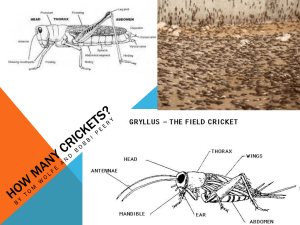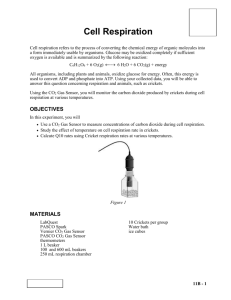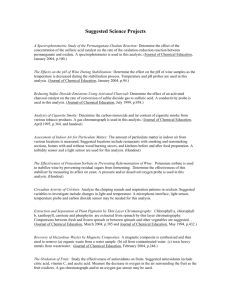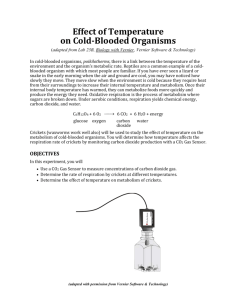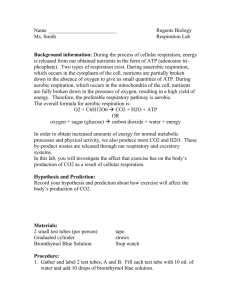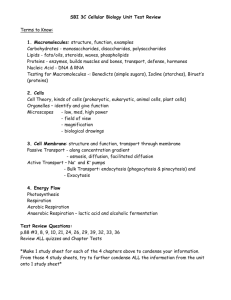Total Dissolved Solids
advertisement
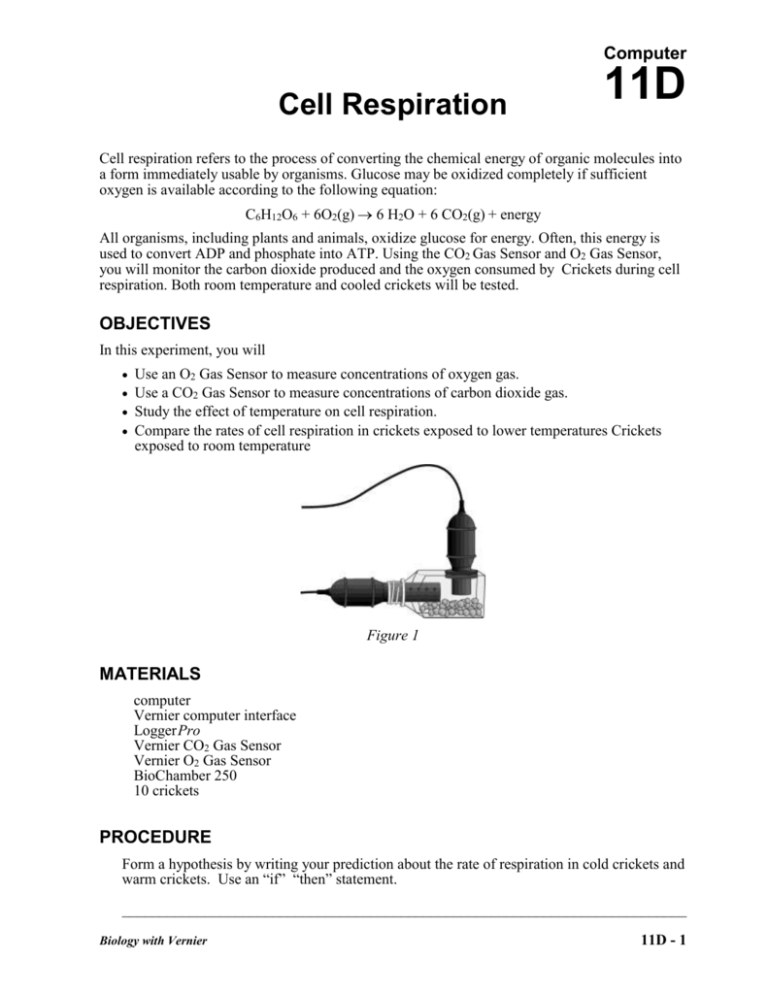
Computer Cell Respiration 11D Cell respiration refers to the process of converting the chemical energy of organic molecules into a form immediately usable by organisms. Glucose may be oxidized completely if sufficient oxygen is available according to the following equation: C6H12O6 + 6O2(g) 6 H2O + 6 CO2(g) + energy All organisms, including plants and animals, oxidize glucose for energy. Often, this energy is used to convert ADP and phosphate into ATP. Using the CO2 Gas Sensor and O2 Gas Sensor, you will monitor the carbon dioxide produced and the oxygen consumed by Crickets during cell respiration. Both room temperature and cooled crickets will be tested. OBJECTIVES In this experiment, you will Use an O2 Gas Sensor to measure concentrations of oxygen gas. Use a CO2 Gas Sensor to measure concentrations of carbon dioxide gas. Study the effect of temperature on cell respiration. Compare the rates of cell respiration in crickets exposed to lower temperatures Crickets exposed to room temperature Figure 1 MATERIALS computer Vernier computer interface Logger Pro Vernier CO2 Gas Sensor Vernier O2 Gas Sensor BioChamber 250 10 crickets PROCEDURE Form a hypothesis by writing your prediction about the rate of respiration in cold crickets and warm crickets. Use an “if” “then” statement. ___________________________________________________________________________ Biology with Vernier 11D - 1 Computer 11D 1. If your CO2 Gas Sensor has a switch, set it to the Low (0–10,000 ppm) setting. Connect the CO2 Gas Sensor to Channel 1 and the O2 Gas Sensor to Channel 2 of the Vernier computer interface. 2. Prepare the computer for data collection by opening the file “11D Cell Respiration (CO2 and O2)” from the Biology with Vernier folder of Logger Pro. 3. Obtain 10 crickets from the front lab counter 4. Place the crickets into the respiration chamber. 5. Place the O2 Gas Sensor into the BioChamber 250 as shown in Figure 1. Insert the sensor snugly into the grommet. The O2 Gas Sensor should remain vertical throughout the experiment. Place the CO2 Gas Sensor into the neck of the respiration chamber as shown in Figure 1. 6. Wait four minutes for readings to stabilize, then begin collecting data by clicking Collect data for ten minutes and 7. When data collection has finished click . . 9. Determine the rate of respiration: a. Click anywhere on the CO2 graph to select it. Click the Linear Fit button, , to perform a linear regression. A floating box will appear with the formula for a best fit line. b. Record the slope of the line, m, as the rate of respiration for your crickets c. Close the linear regression floating box. d. Repeat Steps 9a–c for the O2 graph. DATA Table 1 Condition Temperature (°C) 10 Crickets Table 2 Crickets CO2 Rate of respiration (ppt/min) O2 Rate of consumption (ppt/min) Room temperature Crickets exposed to cold Difference in respiration rate 11D - 2 Biology with Vernier Cell Respiration QUESTIONS 1. Do you have evidence that cell respiration occurred in the crickets? Explain. 2. What is the effect of colder temperatures on the rate of cell respiration in crickets? 3. What molecule were the crickets breaking down to produce ATP energy and CO2 as a by product? Biology with Vernier 11D - 3


